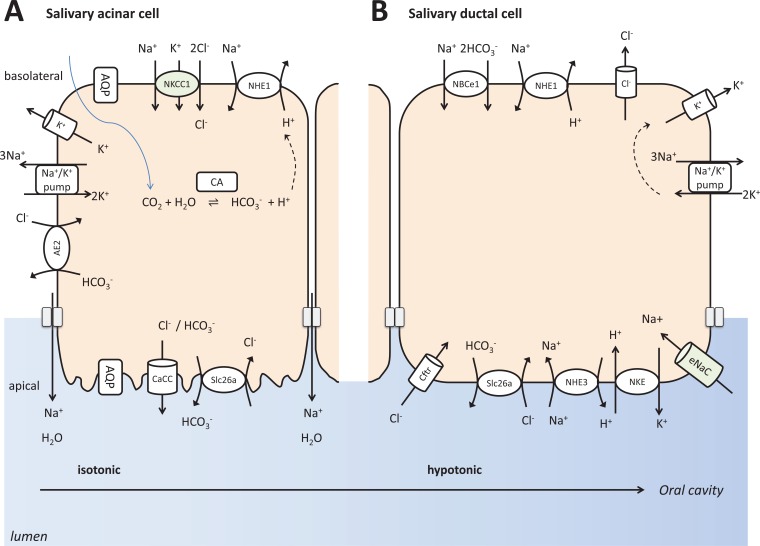Fig. (3).
Simplified model depicting pancreatic ductal and acinar fluid, bicarbonate and electrolyte secretion. The bottom of the figure shows that salivary glands secrete bicarbonate to neutralize acidity in the oral lumen.
(A) Salivary acinar cells secrete an isotonic fluid that also contain various proteins: serous acinar cells excrete α-amylase, while mucous acini produce mucin. The other major function of salivary acinar cells is electrolyte and fluid secretion, creating an isotonic fluid. Similar to the pancreatic acinar cells, basolateral uptake of Cl− through Na+ /K+/Cl− cotransporters is supported by Na+/ K+ ATPase provided gradients. Subsequently, apical secretion of Cl− is mediated by calcium-activated chloride channels (CaCC). Parallel opening of basolateral K+ channels is necessary to keep intracellular electroneutrality. Cl− is followed by Na+ via the paracellular pathway. Then water follows passively through aquaporin water channels and also paracellularly into the lumen. Salivary acinar cells also secrete a modest level of bicarbonate, primarily through apical exchange to already secreted Cl− to intracellularly accumulated bicarbonate via SLC26 anion exchangers.
(B) Salivary duct cells make a hypotonic fluid that is poor in Na+ and Cl− but relatively rich in K+ and HCO3− by absorbing Na+ and Cl−, and to a lower degree secreting K+ and bicarbonate. Na+ reabsorption is achieved by apical epithelial Na+ channels (ENaC) allowing Na+ reuptake from the lumen. Then the Na+/ K+ ATPase extrudes the accumulated Na+ basolaterally. Cl− is also reabsorbed by a transcellular process. Apical Cl− entry into the cell is primarily facilitated by CFTR. Ductal cells effectively absorb Na+ and Cl−, but practically impermeable for water as it lacks aquaporin water channels and their tight junctions are also resistant to water passage. The outcome is a highly hypotonic saliva, reaching the oral cavity at basal secretion. During parasympathetic stimulation, the highly accelerated flow rate does not permit complete Na+ and Cl− reuptake resulting less hypotonic salivary juice, relatively high in bicarbonate. This fluid serves to buffer oral acidification by food and drink, or gastric reflux.

